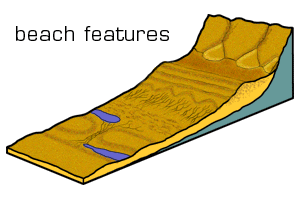Beaches - feature of Coastal deposition
Beaches are features of deposition found in coastal areas between high and low tide. They are generally found in areas where there is an inlet or sheltered area, between headlands or a change in the coastline which causes sediment to be trapped and build up. If a beach is found in a bay it is called a bay head beach.
Beaches are areas of sand, shingle and larger stones. They are created by a number of factors:
Destructive waves are waves that create coastal features. The swash is more powerful than the backwash and material is pushed up the coastline. As the wave flows back down the coastline much of the water percolates down through the sand and the backwash does not have enough energy to remove much material.
Longshore drift is the movement of material along the coastline in a zig-zag manner. The waves approach the beach at an angle but return in a straight manner and sediment is carried along by this process until it is interrupted by a headland or change in coastline.
Beaches can be divided into three main areas:
Foreshore: the part of the beach closest to the water. Here features such as runnels and ridges may be found. These are long rises and depressions in the sand parallel to the coastline and formed by constructive waves breaking.
The middle shore is the part of the beach where ripple marks are found. These are gentle lines in the sand created by the swash. Beach cusps may also be found here. These are crescent shaped hollows in the beach where you tend to find the shingle changes to softer sand. Berms are long, narrow ridges of stones and shingles which tend to mark the dividing point of the middle shore and backshore. This tends to be the area that the waves reach when the tide is in.
Finally the backshore is the area where the storm beach, sand dunes and cliff face are found. A storm beach is the area where strong waves have moved larger pieces of material up the beach. Some beaches have natural or man-made dunes (mounds of sand usually anchored by marram grass) and some have boulder clay or rocky cliffs marking the end of the beach.
Examples of beaches include:
· Dollymount Strand, Dublin.
· Curracloe Beach, Wexford
· Bondi Beach, Sydney, Australia.
When drawing a diagram of a beach, try to show the location and shape of each of the features mentioned above. Use neat arrows or a key system. Frame and title your diagram.
Beaches are areas of sand, shingle and larger stones. They are created by a number of factors:
Destructive waves are waves that create coastal features. The swash is more powerful than the backwash and material is pushed up the coastline. As the wave flows back down the coastline much of the water percolates down through the sand and the backwash does not have enough energy to remove much material.
Longshore drift is the movement of material along the coastline in a zig-zag manner. The waves approach the beach at an angle but return in a straight manner and sediment is carried along by this process until it is interrupted by a headland or change in coastline.
Beaches can be divided into three main areas:
Foreshore: the part of the beach closest to the water. Here features such as runnels and ridges may be found. These are long rises and depressions in the sand parallel to the coastline and formed by constructive waves breaking.
The middle shore is the part of the beach where ripple marks are found. These are gentle lines in the sand created by the swash. Beach cusps may also be found here. These are crescent shaped hollows in the beach where you tend to find the shingle changes to softer sand. Berms are long, narrow ridges of stones and shingles which tend to mark the dividing point of the middle shore and backshore. This tends to be the area that the waves reach when the tide is in.
Finally the backshore is the area where the storm beach, sand dunes and cliff face are found. A storm beach is the area where strong waves have moved larger pieces of material up the beach. Some beaches have natural or man-made dunes (mounds of sand usually anchored by marram grass) and some have boulder clay or rocky cliffs marking the end of the beach.
Examples of beaches include:
· Dollymount Strand, Dublin.
· Curracloe Beach, Wexford
· Bondi Beach, Sydney, Australia.
When drawing a diagram of a beach, try to show the location and shape of each of the features mentioned above. Use neat arrows or a key system. Frame and title your diagram.
| beaches_feed.docx | |
| File Size: | 37 kb |
| File Type: | docx |

